NATIONAL PARK SERVICE
Park Structures and Facilities
|

|
LOOKOUT TOWERS and OVERLOOKS
WITHIN the compass of this heading is included a wide
range of structures, the common denominator of all being the provision
of means for negotiating a view. Lookouts may eventuate from the
practical requirement of forest fire detection, or from determination on
the part of designing technician or wilful band of park users,
hyper-view conscious, for something bigger and better and more distant
in views than Nature unaided could achieve.
Between the grimly functional lookout of the ranger
and the utmost in aesthetic structural elevation contrived by the
view-for-view's-sakers is greater distance than any park vista will ever
provide. When it has been essayed to superimpose the too conscious
aspirations of the aesthetic, on the structurally sufficient skeleton of
the fire detection tower, the literally "crowning" error in park
development has been committed. Probably a frank rendering of either
extreme, free of gesture toward the other, is better than any hybrid
produced by crossing the two irreconcilables.
Examination of existing timber-framed trestle-type
lookout towers for aesthetic values will prove disheartening. In
general, the oil derrick as their inspirational source is painfully
undisguised. This conclusion cannot be held in disparagement of the
designers, if it be honestly admitted that they have valiantly sought to
solve the unsolvable. There is such admirable show of
there-is-no-such-word-as-can't in every new attempt! It seems heartless
to venture a restraining word, but the accumulation in our parks of
harrowing skeletons commemorative of past ill-advised best intentions in
this direction admits no choice of action.
There are other than purely aesthetic reasons for
discouraging the building of high wooden structures for use as
observation towers. It is very difficult, if not impossible, to
fabricate a timber-braced structure with bolted or spiked joints that
will hold up under the attack of the elements for any considerable
length of time without constant maintenance. Immediately after
construction the wood members shrink and the joints loosen. Decay will
proceed rapidly at the joints where water seeps in between the members
and finally into the bolt and spike holes. The structure is weakened at
its most vulnerable point. With the slightest loosening of the joints
the tremendous wind pressures cause movements which increase the
stresses in the entire structure. The safety of the people using the
towers cannot be assured, when it depends entirely on inspection and
maintenance that cannot be guaranteed into the future.
Because the wood-framed lookout tower is so utterly
unappealing, and so potentially a hazard, it is strange that but few
stone towers have been built. The stone lookout is not foredoomed to
failure, aesthetic and structural, as is the open wood tower, but on the
contrary offers opportunity for picturesqueness, satisfying design and
great permanence. Particularly does it appear that the possibilities for
a stone tower of modest height springing from a rock-crowned summit have
not been widely sensed, certainly not widely embraced.
It is held by many that the birth rate for lookout
towers in parks is currently too high, and that some measure of control
should be instituted. It can be argued that the perching of a lookout on
the high elevation of a park area is disfiguring to the natural sky
line, that it is sometimes better to remove the trees that crown the
high summit, and are the very obstructions to view that make necessary
the building of a structural lookout. The bald crown of the eminence is
held to be a lesser, certainly no greater, blemish than the structural
tower rearing itself above trees. There are undoubtedly locations where
this solution would be an acceptable alternative to a lookout tower. But
it can hardly be urged for universal application. Rather should it be
given thoughtful consideration as a possibility, to be weighed in the
light of consideration of characteristics of hill or mountain top
contours and prevalence of forest cover.
There is another less blatant type of lookout,
without aspirations to become a tower of Babel, often termed an
overlook, trail lookout or lookout shelter and usually strategically
located at a prospect point of an upland, where the hiker is offered
rest and shelter and a view. These little structures are notable for
their general lack of pretentious character, and several successful
examples of such are illustrated by photographs and drawings on
succeeding pages. It must be admitted that these might as logically have
been included within the shelter section. Perhaps the reader will
withhold censure of this straining in classification and wink at this
subterfuge as pardonable in the circumstances. The "batting average" for
lookout towers without the beneficial rating of overlooks is such that
it stands in need of any advantage that can be fairly given it.
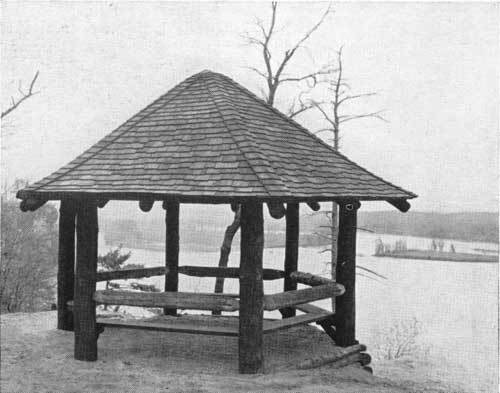
|
|
OVERLOOK—STARVED ROCK STATE PARK—ILLINOIS
A hexagonal overlook structure of
simple construction so photographed as to show the distant view that is
its reason for being. No other purpose that might inspire a small
shelter building offers benefits measuring up to those furnished by a
sweeping view of a far horizon. A double or triple railing might have
overcome the disturbing "openness" of the single rail that has here been
used and have contributed a solidity to the base of the structure that
seems to be lacking.
|
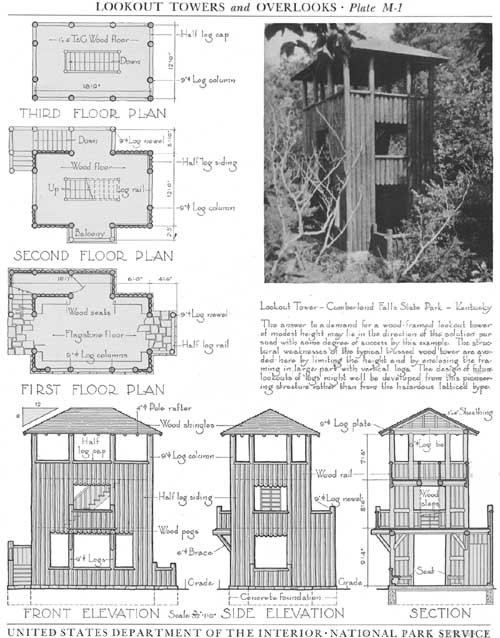
|
|
Plate M-1 (click on image for a PDF version)
|
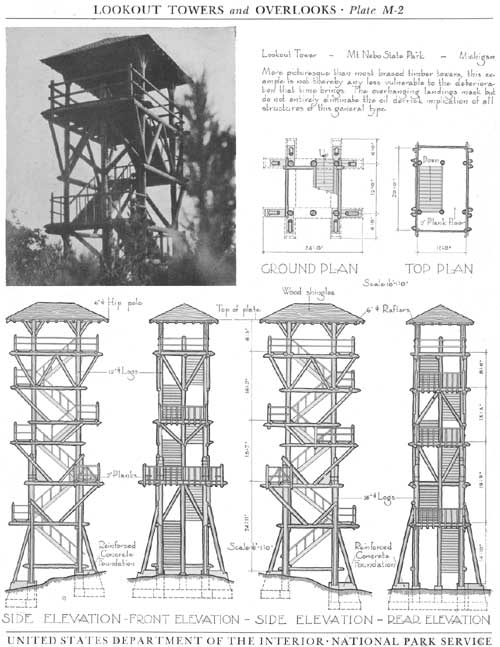
|
|
Plate M-2 (click on image for a PDF version)
|
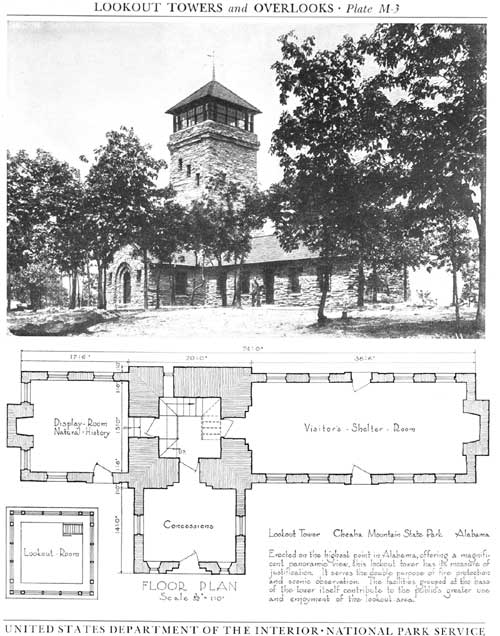
|
|
Plate M-3 (click on image for a PDF version)
|
Lookout Shelter, Meramec State Park, Missouri
It is suggested to all who would build tall trussed
timber lookout tower that they pause and consider on its merits such a
lookout as this. It is more enduring and comparatively free from
maintenance demands, and very much more at home on a rocky eminence than
any wood tower ever contrived. It offers a view in all directions and
shelter from sudden storms. The batter at the base of the wall is
pleasing. Perhaps the low pitch of the roof and the thinness of roof
covering could be quarreled with.
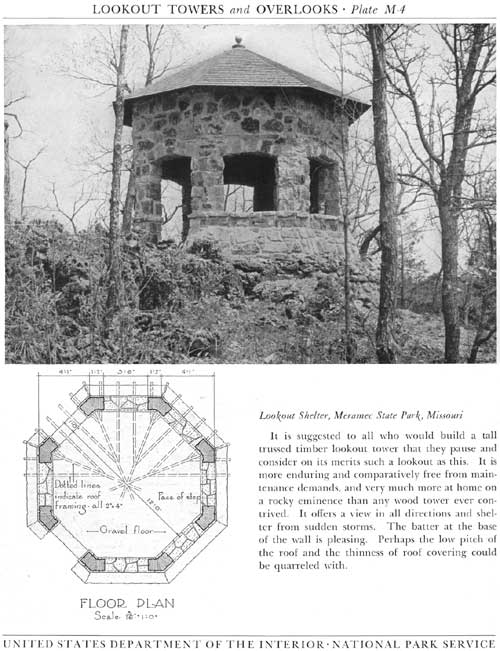
|
|
Plate M-4 (click on image for a PDF version)
|
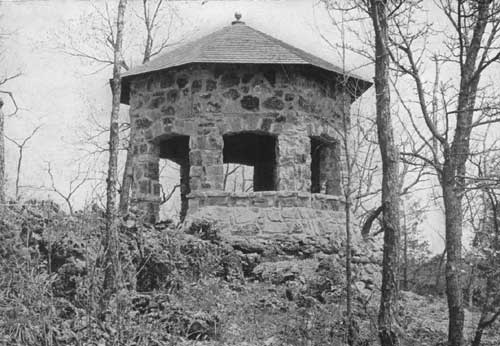
|
|
Meramec State Park, Missouri
|
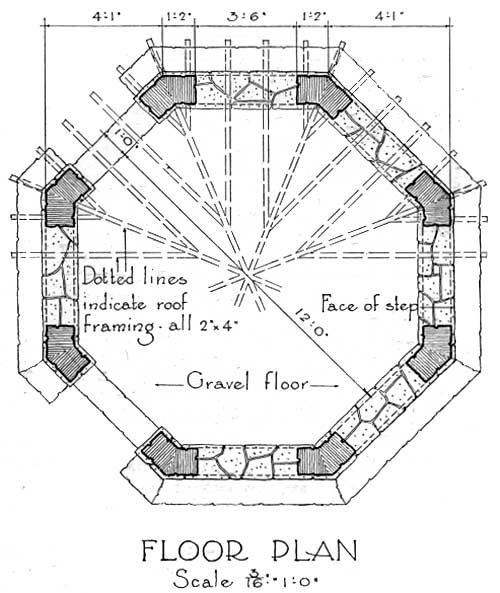
|
|
Meramec State Park, Missouri
|
Observation Station, Grand Canyon National Park
Perched on the rim of this spectacular canyon, this
structure forms liaison with its setting by means of native stone
ruggedly laid, flat roof, skillfully buttressed corners. Before a
lecture group at the observation point the majestic canyon—subject
of the talks—spreads uninterruptedly.
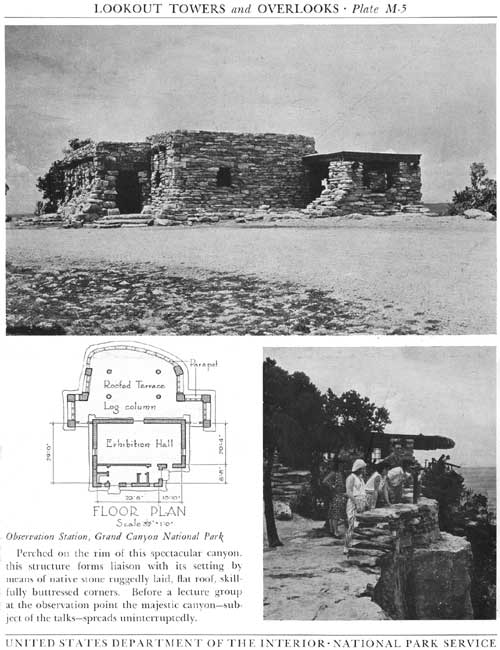
|
|
Plate M-5 (click on image for a PDF version)
|
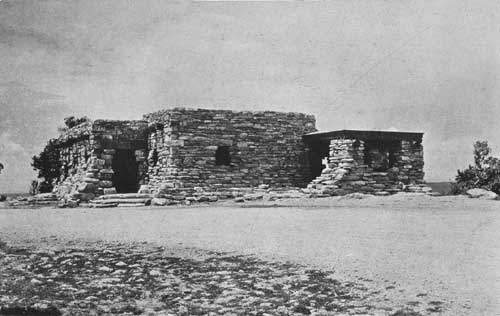
|
|
Grand Canyon National Park
|
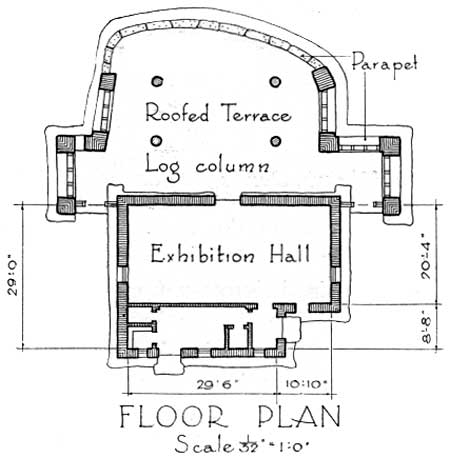
|
|
Grand Canyon National Park
|
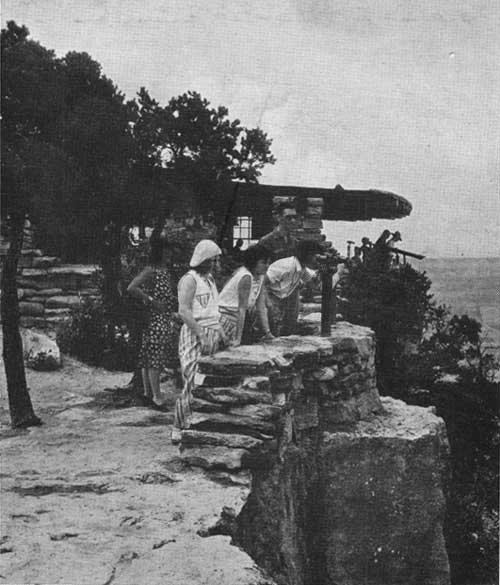
|
|
Grand Canyon National Park
|
Overlook Shelter, Devil's Den State Park, Arkansas
Nominated from the floor as a candidate for a
Pulitzer Award for Park Structures, if and when created. This little
structure will cause chagrin and consternation among experts in
destructive criticism who will be hard put to ferret out its
shortcomings. An inventory of all its points of high merit is impossible
in a limited space, but would surely lead off with blending to site,
character of rock work and vigorous scale of the log timbers. The
picturesque tree is flattering to the structure, but, it must be
admitted, with unquestionable justification.
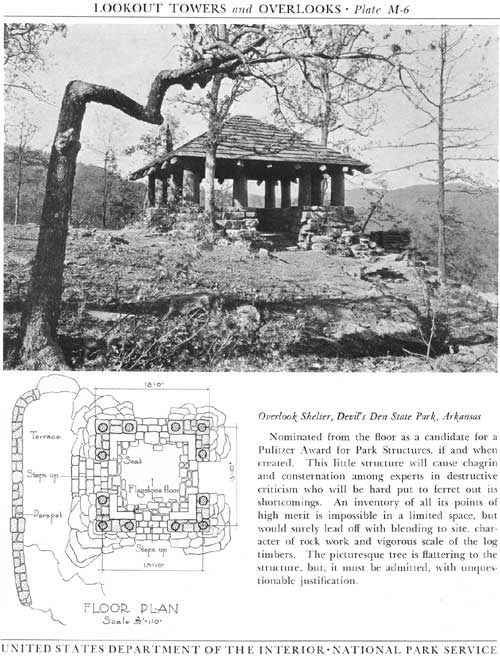
|
|
Plate M-6 (click on image for a PDF version)
|
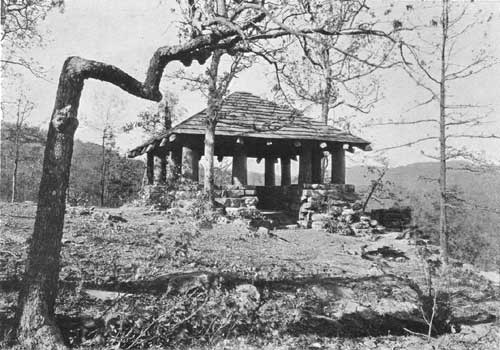
|
|
Devil's Den State Park, Arkansas
|
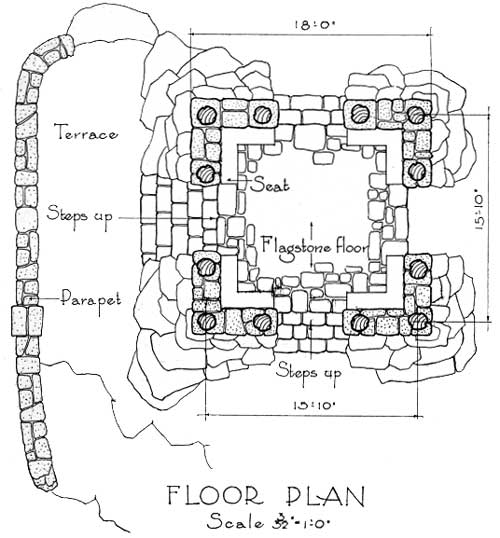
|
|
Devil's Den State Park, Arkansas
|
Lookout, Muskegon State Park, Michigan
A graceful salute to the days of the Frontier! For
the pleasantly dishonest authenticity of this new-old blockhouse we are
indebted to the salvaged timbers of a wrecked lake vessel. This lookout
inspires recall of vanished men and vanquished wilderness—a shrine
for the Unknown Pioneer.
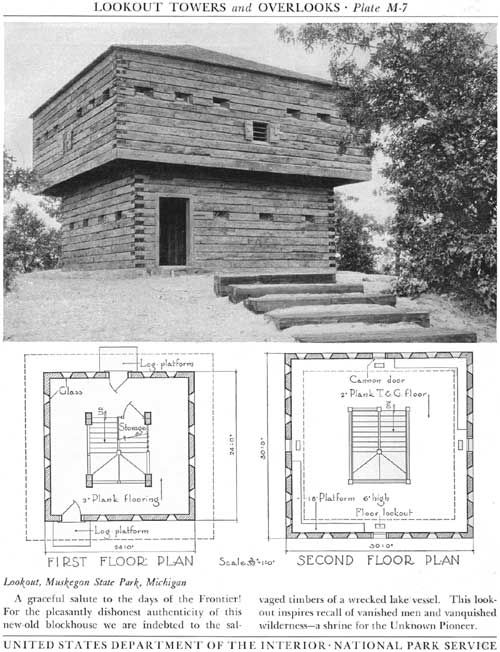
|
|
Plate M-7 (click on image for a PDF version)
|
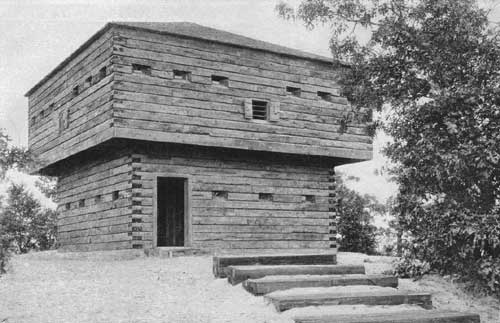
|
|
Muskegon State Park, Michigan
|
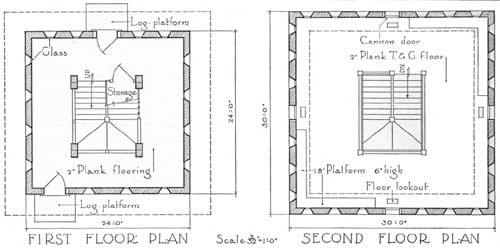
|
|
Muskegon State Park, Michigan
|
Lookout Shelter, Mississippi Palisades State Park, Illinois
High in the merit list of lookout shelters, this
jaunty little building of hand-hewn timbers as here illustrated basks in
the full added benefit of dramatic photography. To those who must have
something to cavil at, the excessive "beavering" of the rail members is
suggested. But accelerated personality is more than compensatory for any
minor sacrifice of structural maximum. Opposite are detail drawings of
the building.
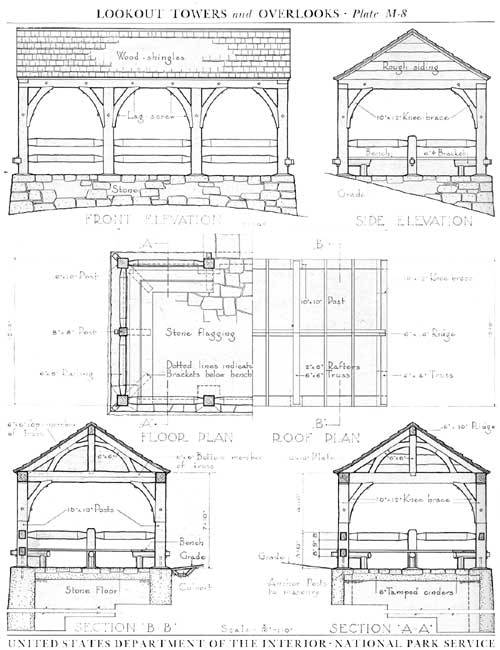
|
|
Plate M-8 (click on image for a PDF version)
|
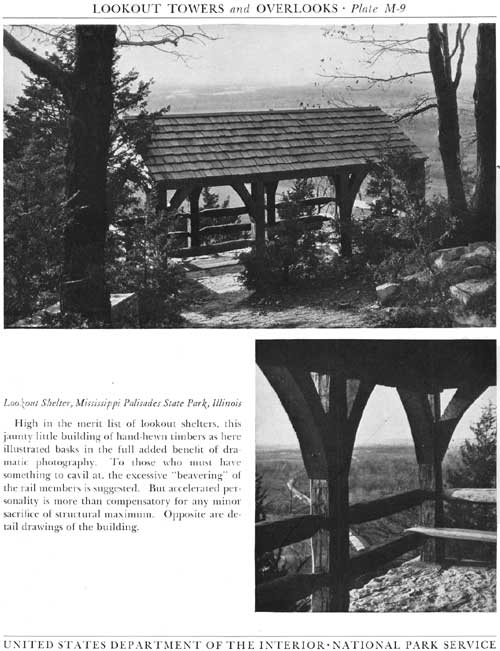
|
|
Plate M-9 (click on image for a PDF version)
|
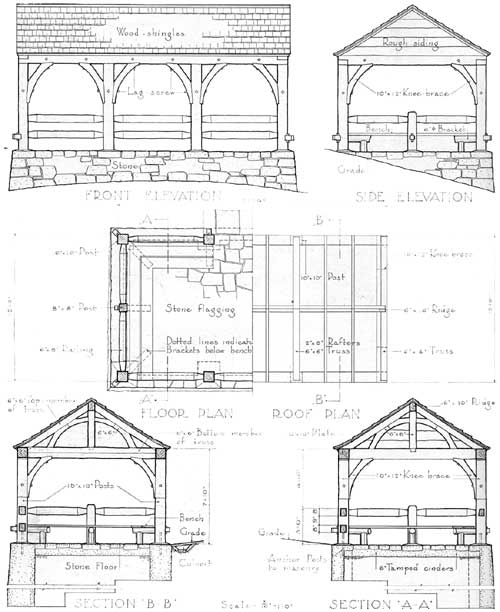
|
|
Mississippi Palisades State Park, Illinois
|
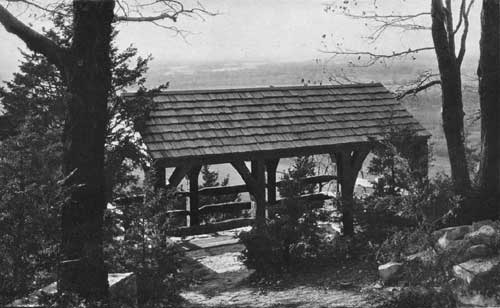
|
|
Mississippi Palisades State Park, Illinois
|

|
|
Mississippi Palisades State Park, Illinois
|
Overlook Shelter, Buttermilk Falls State Park, New York
Happily illustrative of escape from the bondage of
the prosaic in shelter buildings, both in plan and exterior treatment.
Abundance of doors and windows gives views in all directions and still
permits the enclosing of the shelter in cool weather. The retaining wall
is of interest by reason of its batter rather than adherence to all the
laws of good masonry. It is unfortunate that the general ruggedness of
the structure did not extend to the roofing material, which is thin and
inadequate.
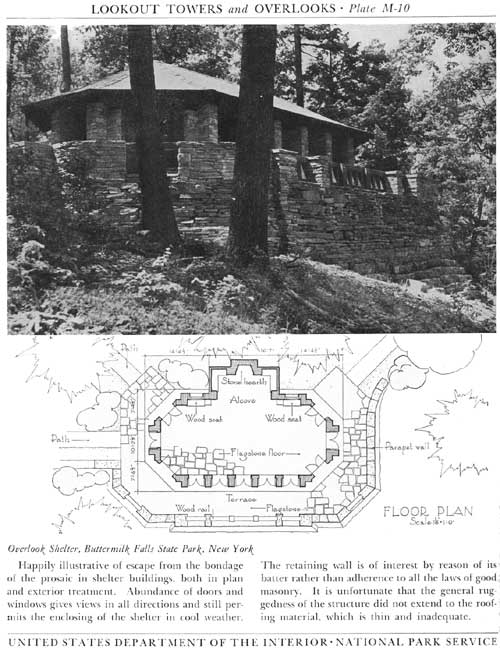
|
|
Plate M-1 (click on image for a PDF version)
|
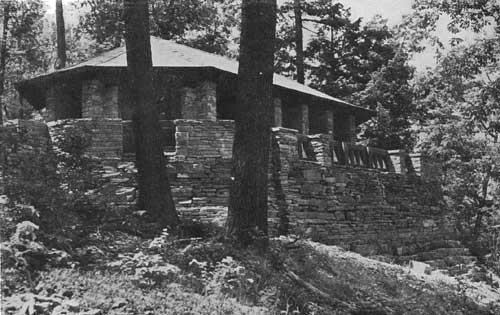
|
|
Buttermilk Falls State Park, New York
|
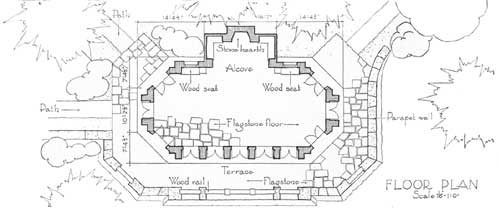
|
|
Buttermilk Falls State Park, New York
|
park_structures_facilities/secm.htm
Last Updated: 5-Dec-2011
| 
























